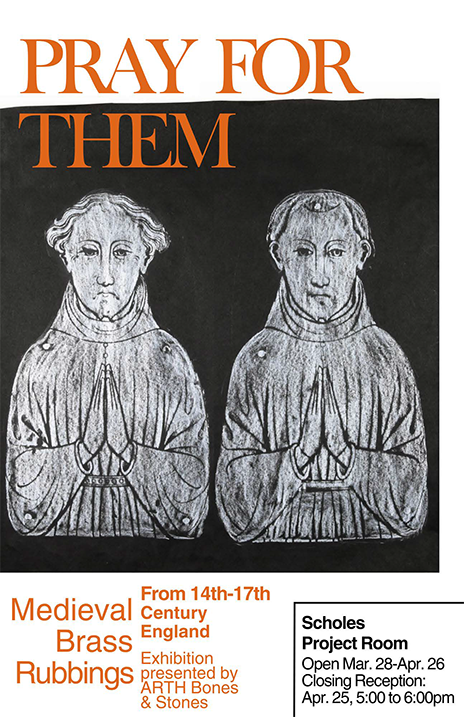Scholes Library exhibiting collection of brass rubbings: captured images of the deceased laid to rest in English medieval churches

Scholes Library is hosting an exhibition of brass rubbings – images captured on paper from brass monuments laid in the floors of medieval churches. The collection has been curated by Alfred University students enrolled in the “Bones and Stones” seminar taught by Assistant Professor of Art History Meg Bernstein, School of Art and Design. It will run through April 25.
Bones and Stones will host a closing reception at the Scholes Project Room on April 25 from 5-6 pm. All are welcome!
The exhibition, “Pray for Them,” is a collection of reproductions taken from monumental brasses set in English churches between 1300 and 1600, according to John Hosford, Scholes Library Art Librarian. Monumental brasses are images representing deceased parishioners cast in brass and set in church floors – frequently on their coffins. They provided an opportunity for worshippers entering the churches to pray for the souls of the deceased. Medieval Christian theology taught such prayers hastened a soul’s journey through Purgatory.
Many of the brass rubbings have been in the Herrick Library collection for decades and were recently transferred to Scholes Library. They originally were donated to Herrick Library by Dorothy Towe, a former counselor for Alfred University who enjoyed making brass rubbings during travels through southern England in the late 1960s. Most of the rubbings have been stored in the University Archives since they were donated in the 1980s.
Bernstein says she was “delighted” to learn that Alfred owned a collection so relevant to her seminar topic, noting that brass rubbings have provided an opportunity for her students to conduct original research on death in medieval material culture.
The collection became the focus of a project by “Bones and Stones” art history students collaborating with Scholes Library. The project had three components: preservation, digital access, and student scholarship. While the physical brass rubbings will be part of Scholes Library’s permanent collection, they also have been converted into a digital collection of photography and metadata. The collection will be available for viewing on the JSTOR Forum.
The full title of Bernstein’s Art History class is "Bones and Stones: The Art of Death in the Middle Ages." It is a seminar “that examines the art and architecture created in preparation for and response to death in medieval Europe,” according to its class description. Students enrolled in the class include Ella Becher, Jemma Lindquist, Cassidy Mountain, Dot Santiago, Em Sexsmith, and Juno Tangry.
The students’ classwork involved analyzing and interpreting monumental brasses, an exercise that enhances critical thinking and visual analysis skills, as well as researching the brasses in a vast body of scholarly literature on the topic. The students selected which objects from the collection would be displayed and how, wrote didactic text panels, created maps, designed promotional materials, and painted signage. In the process of creating metadata for the digital collection, the students also were introduced to basic concepts of data literacy and data organization.
